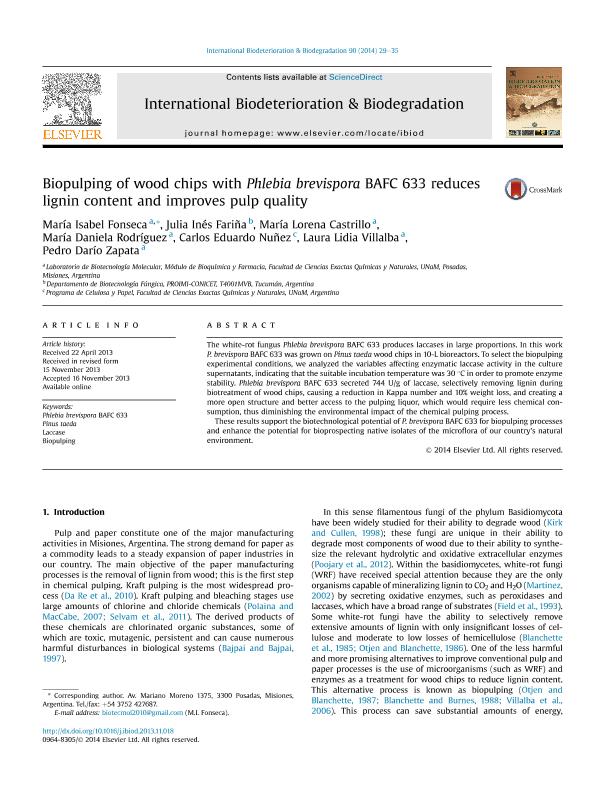Artículo
Biopulping of wood chips with Phlebia brevispora BAFC 633 reduces lignin content and improves pulp quality
Fonseca, Maria Isabel ; Fariña, Julia Ines
; Fariña, Julia Ines ; Castrillo, María Lorena
; Castrillo, María Lorena ; Rodríguez, María Daniela
; Rodríguez, María Daniela ; Nuñez, Carlos Eduardo; Villalba, Laura; Zapata, Pedro Dario
; Nuñez, Carlos Eduardo; Villalba, Laura; Zapata, Pedro Dario
 ; Fariña, Julia Ines
; Fariña, Julia Ines ; Castrillo, María Lorena
; Castrillo, María Lorena ; Rodríguez, María Daniela
; Rodríguez, María Daniela ; Nuñez, Carlos Eduardo; Villalba, Laura; Zapata, Pedro Dario
; Nuñez, Carlos Eduardo; Villalba, Laura; Zapata, Pedro Dario
Fecha de publicación:
02/2014
Editorial:
Elsevier
Revista:
International Biodeterioration and Biodegradation
ISSN:
0964-8305
e-ISSN:
0964-8305
Idioma:
Inglés
Tipo de recurso:
Artículo publicado
Clasificación temática:
Resumen
The white-rot fungus Phlebia brevispora BAFC 633 produces laccases in large proportions. In this work P. brevispora BAFC 633 was grown on Pinus taeda wood chips in 10-L bioreactors. To select the biopulping experimental conditions, we analyzed the variables affecting enzymatic laccase activity in the culture supernatants, indicating that the suitable incubation temperature was 30 °C in order to promote enzyme stability. Phlebia brevisporaBAFC 633 secreted 744 U/g of laccase, selectively removing lignin during biotreatment of wood chips, causing a reduction in Kappa number and 10% weight loss, and creating a more open structure and better access to the pulping liquor, which would require less chemical consumption, thus diminishing the environmental impact of the chemical pulping process. These results support the biotechnological potential of P. brevispora BAFC 633 for biopulping processes and enhance the potential for bioprospecting native isolates of the microflora of our country's natural environment.
Palabras clave:
Phlebia Brevispora Bafc 633
,
Pinus Taeda
,
Laccase
,
Biopulping
Archivos asociados
Licencia
Identificadores
Colecciones
Articulos(CCT - NORDESTE)
Articulos de CTRO.CIENTIFICO TECNOL.CONICET - NORDESTE
Articulos de CTRO.CIENTIFICO TECNOL.CONICET - NORDESTE
Citación
Fonseca, Maria Isabel; Fariña, Julia Ines; Castrillo, María Lorena; Rodríguez, María Daniela; Nuñez, Carlos Eduardo; et al.; Biopulping of wood chips with Phlebia brevispora BAFC 633 reduces lignin content and improves pulp quality; Elsevier; International Biodeterioration and Biodegradation; 90; 2-2014; 29-35
Compartir
Altmétricas



